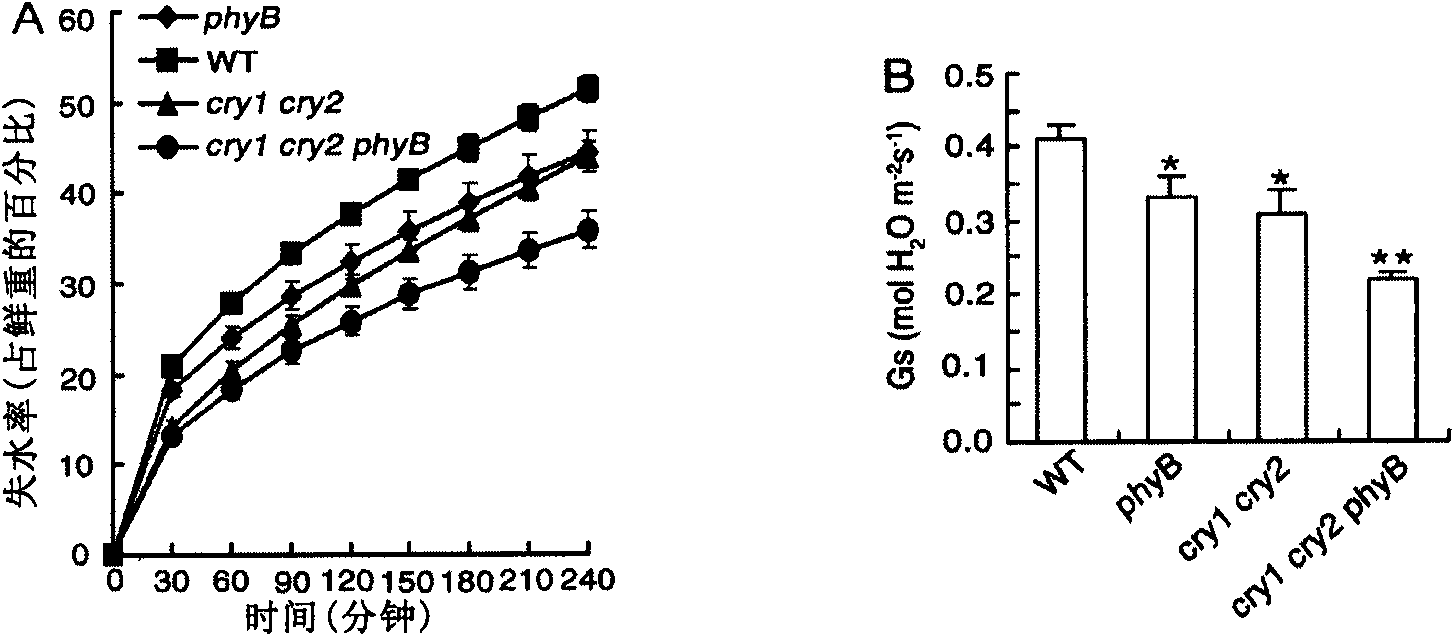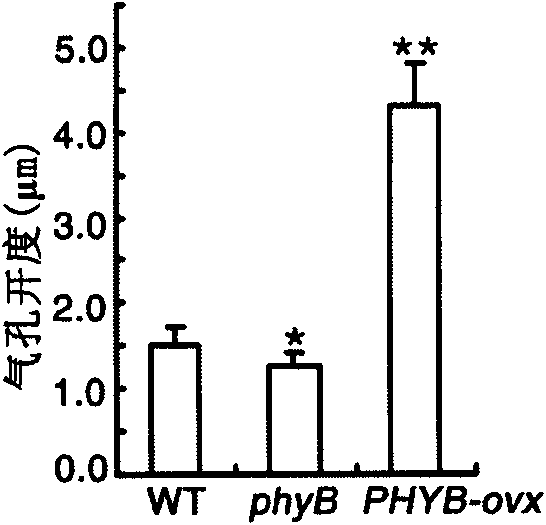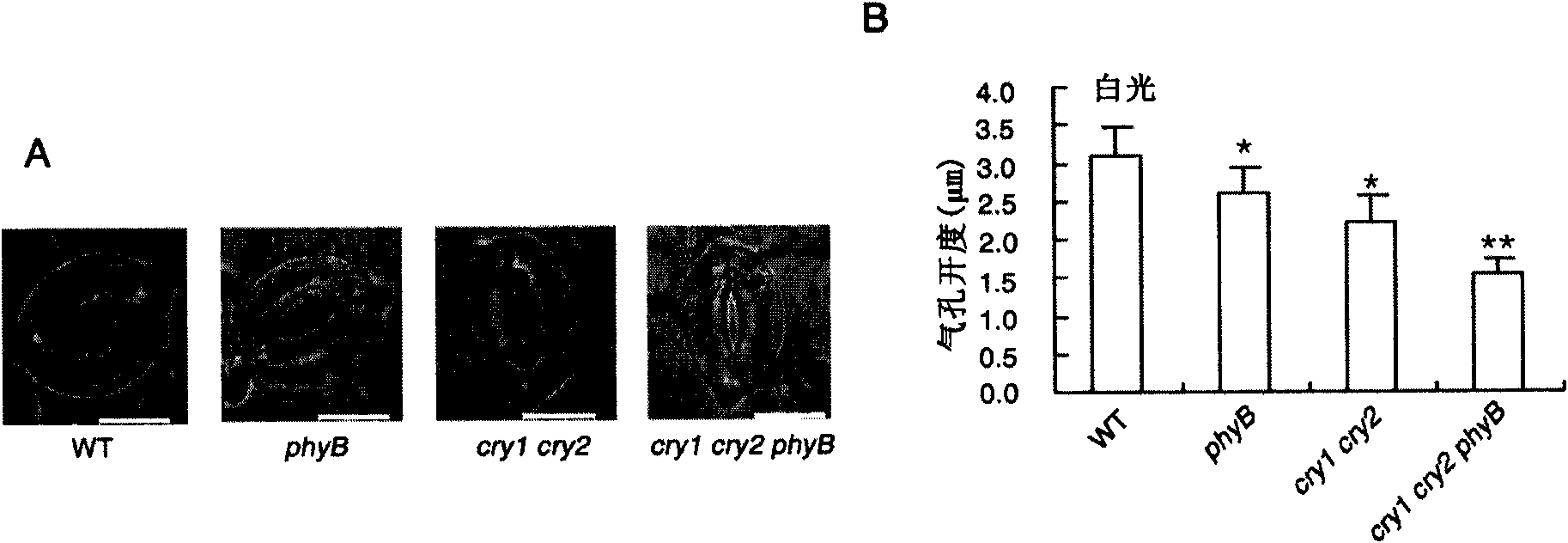Method of changing stomatal aperture and density of plant
A plant and stomatal technology, applied in the field of agricultural science, to achieve the effect of improving plant quality and adaptability
- Summary
- Abstract
- Description
- Claims
- Application Information
AI Technical Summary
Problems solved by technology
Method used
Image
Examples
Embodiment 1
[0103] Example 1: Construction of cry1cry2phyB triple mutant
[0104] Dicotyledonous seeds are chemically or physically mutagenized to create mutant libraries (see literature listed above for cry1, cry2 and phyB genes).
[0105] Seedlings of the M2 generation were screened for high hypocotyl height under strong blue light, weak blue light, red light and far red light. The mutants with increased hypocotyls obtained under weak blue light were transplanted into the soil, and the mutants with delayed flowering time were selected. The mutants with increased hypocotyls obtained under red light were transplanted into the soil, and the mutants with early flowering time were selected.
[0106] The CRY1, CRY2, PHYA, and PHYB sites of the above mutants were respectively amplified by PCR, and the mutation sites were determined by sequencing to obtain single mutants. After the determined cry1, cry2, phyA and phyB mutants are obtained, the cry1 and cry2 mutants can be crossed first to o...
Embodiment 2
[0107] Example 2: Construction of overexpressed CRY1, CRY2 and phyB transgenic plants
[0108] The full-length cDNAs of CRY1, CRY2 and PHYB (respectively SEQ IDNOs: 1, 3 and 5) were respectively obtained by PCR method, and inserted into the downstream of the 35S promoter of the pKY71 vector or PHB vector, respectively, to obtain the overexpression of CRY1, CRY2 and phyB respectively. Plant expression vector. These vectors are then used to transform plants respectively to obtain transgenic plants. under moderate intensity blue light (20 μmol·m -2 ·s -1 ), weak blue light (1-5μmol·m -2 ·s -1 ) and red light conditions to screen seedlings with significantly shortened hypocotyls, and the obtained transgenic plants were transgenic plants overexpressing CRY1, CRY2 and phyB, respectively.
Embodiment 3
[0109] Embodiment 3: the research of pore density and opening degree
[0110] Light source and instrument
[0111]The light source used when measuring the porosity coefficient is an LED screen, the wavelength of blue light is 469 nanometers, the wavelength of red light is 680 nanometers, and the wavelength of far-red light is 730 nanometers. The temperature under continuous light conditions was 22°C. The instruments used for light intensity measurement are Li250 light quantum measuring instrument and ILT1400-A photometer (ILT, MA, USA) of Li-Cor Company in the United States.
[0112] Water loss test
[0113] Take isolated rosette leaves of WT (wild type), phyB, cry1cry2, and cry1cry2phyB Arabidopsis plants that have been cultured for 21 days, and place them in a continuous 140 μmol m -2 ·s -1 Under the condition of incandescent fluorescent lamp irradiation, measure its water loss, expressed as the weight percent of initial fresh leaves (as described by Leung, J., Mer...
PUM
 Login to View More
Login to View More Abstract
Description
Claims
Application Information
 Login to View More
Login to View More - R&D
- Intellectual Property
- Life Sciences
- Materials
- Tech Scout
- Unparalleled Data Quality
- Higher Quality Content
- 60% Fewer Hallucinations
Browse by: Latest US Patents, China's latest patents, Technical Efficacy Thesaurus, Application Domain, Technology Topic, Popular Technical Reports.
© 2025 PatSnap. All rights reserved.Legal|Privacy policy|Modern Slavery Act Transparency Statement|Sitemap|About US| Contact US: help@patsnap.com



